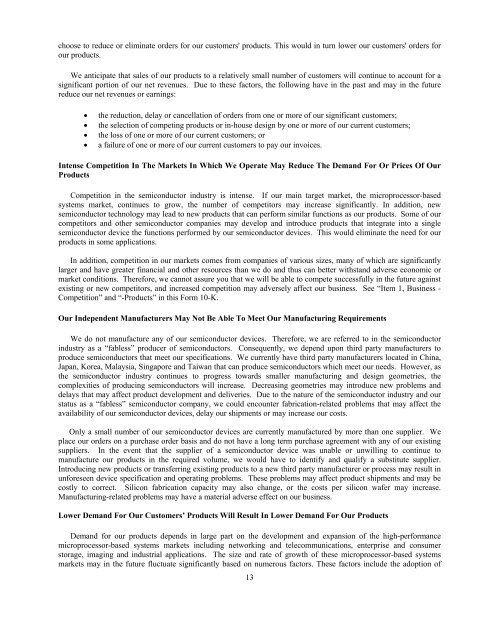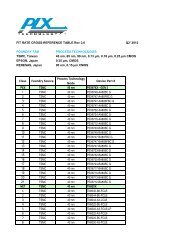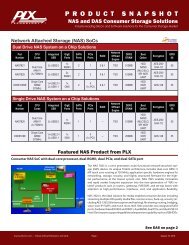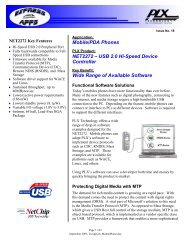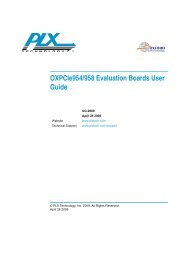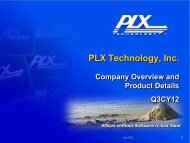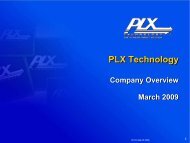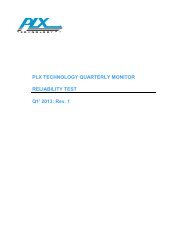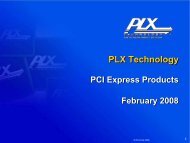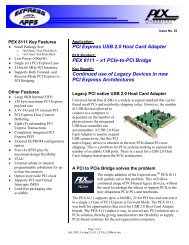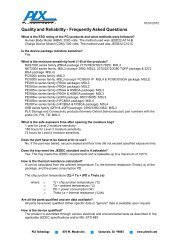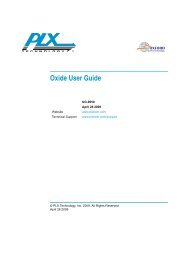the 2009 Annual Report (pdf) - PLX Technology
the 2009 Annual Report (pdf) - PLX Technology
the 2009 Annual Report (pdf) - PLX Technology
Create successful ePaper yourself
Turn your PDF publications into a flip-book with our unique Google optimized e-Paper software.
choose to reduce or eliminate orders for our customers' products. This would in turn lower our customers' orders for<br />
our products.<br />
We anticipate that sales of our products to a relatively small number of customers will continue to account for a<br />
significant portion of our net revenues. Due to <strong>the</strong>se factors, <strong>the</strong> following have in <strong>the</strong> past and may in <strong>the</strong> future<br />
reduce our net revenues or earnings:<br />
• <strong>the</strong> reduction, delay or cancellation of orders from one or more of our significant customers;<br />
• <strong>the</strong> selection of competing products or in-house design by one or more of our current customers;<br />
• <strong>the</strong> loss of one or more of our current customers; or<br />
• a failure of one or more of our current customers to pay our invoices.<br />
Intense Competition In The Markets In Which We Operate May Reduce The Demand For Or Prices Of Our<br />
Products<br />
Competition in <strong>the</strong> semiconductor industry is intense. If our main target market, <strong>the</strong> microprocessor-based<br />
systems market, continues to grow, <strong>the</strong> number of competitors may increase significantly. In addition, new<br />
semiconductor technology may lead to new products that can perform similar functions as our products. Some of our<br />
competitors and o<strong>the</strong>r semiconductor companies may develop and introduce products that integrate into a single<br />
semiconductor device <strong>the</strong> functions performed by our semiconductor devices. This would eliminate <strong>the</strong> need for our<br />
products in some applications.<br />
In addition, competition in our markets comes from companies of various sizes, many of which are significantly<br />
larger and have greater financial and o<strong>the</strong>r resources than we do and thus can better withstand adverse economic or<br />
market conditions. Therefore, we cannot assure you that we will be able to compete successfully in <strong>the</strong> future against<br />
existing or new competitors, and increased competition may adversely affect our business. See “Item 1, Business -<br />
Competition” and “-Products” in this Form 10-K.<br />
Our Independent Manufacturers May Not Be Able To Meet Our Manufacturing Requirements<br />
We do not manufacture any of our semiconductor devices. Therefore, we are referred to in <strong>the</strong> semiconductor<br />
industry as a “fabless” producer of semiconductors. Consequently, we depend upon third party manufacturers to<br />
produce semiconductors that meet our specifications. We currently have third party manufacturers located in China,<br />
Japan, Korea, Malaysia, Singapore and Taiwan that can produce semiconductors which meet our needs. However, as<br />
<strong>the</strong> semiconductor industry continues to progress towards smaller manufacturing and design geometries, <strong>the</strong><br />
complexities of producing semiconductors will increase. Decreasing geometries may introduce new problems and<br />
delays that may affect product development and deliveries. Due to <strong>the</strong> nature of <strong>the</strong> semiconductor industry and our<br />
status as a “fabless” semiconductor company, we could encounter fabrication-related problems that may affect <strong>the</strong><br />
availability of our semiconductor devices, delay our shipments or may increase our costs.<br />
Only a small number of our semiconductor devices are currently manufactured by more than one supplier. We<br />
place our orders on a purchase order basis and do not have a long term purchase agreement with any of our existing<br />
suppliers. In <strong>the</strong> event that <strong>the</strong> supplier of a semiconductor device was unable or unwilling to continue to<br />
manufacture our products in <strong>the</strong> required volume, we would have to identify and qualify a substitute supplier.<br />
Introducing new products or transferring existing products to a new third party manufacturer or process may result in<br />
unforeseen device specification and operating problems. These problems may affect product shipments and may be<br />
costly to correct. Silicon fabrication capacity may also change, or <strong>the</strong> costs per silicon wafer may increase.<br />
Manufacturing-related problems may have a material adverse effect on our business.<br />
Lower Demand For Our Customers’ Products Will Result In Lower Demand For Our Products<br />
Demand for our products depends in large part on <strong>the</strong> development and expansion of <strong>the</strong> high-performance<br />
microprocessor-based systems markets including networking and telecommunications, enterprise and consumer<br />
storage, imaging and industrial applications. The size and rate of growth of <strong>the</strong>se microprocessor-based systems<br />
markets may in <strong>the</strong> future fluctuate significantly based on numerous factors. These factors include <strong>the</strong> adoption of<br />
13


